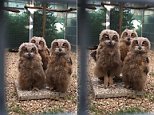The collective noun for a group of owls – a question that has ruffled the feathers of ornithologists and piqued the curiosity of logophiles for ages. Is it a congress? A hoot? Or the perhaps more regal-sounding parliament? The answer, as it often is in the realm of collective nouns, is nuanced, delightful, and deeply rooted in history and observation.
Prepare to have your understanding of avian nomenclature significantly expanded as we embark on a journey to uncover the definitive designation for a gathering of these enigmatic birds of prey. This exploration transcends mere terminology; it delves into the very essence of how we perceive and categorize the natural world.
The notion of a “congress” of owls, while possessing a certain inherent logic suggesting a gathering of wise, deliberative beings, lacks widespread acceptance within the ornithological community. The term, more commonly associated with legislative bodies and formal assemblies, feels somewhat anthropomorphic when applied to the often solitary or loosely associated habits of owls. It implies a level of organization and purpose that may not accurately reflect their social dynamics.
Furthermore, while the characteristic vocalization of owls is undoubtedly a “hoot,” designating an entire group as such lacks the specificity and gravitas often sought in collective nouns. Imagine referring to a collection of ravens as a “caw” or a flock of geese as a “honk.” While amusing in a playful context, such designations fail to capture the inherent dignity and mystique associated with these creatures.
So, if not a congress or a hoot, what collective noun truly captures the essence of a group of owls? The answer, resonating with historical precedent and literary charm, is “parliament.”
The term “parliament of owls” first gained prominence through literary usage, most notably in C.S. Lewis’s *The Chronicles of Narnia*. However, its origins extend beyond the realm of fantasy literature. The notion of owls as wise and contemplative creatures, akin to the learned members of a legislative body, dates back centuries. This association, steeped in symbolism and folklore, contributed to the enduring appeal of “parliament” as the preferred collective noun.
The choice of “parliament” also subtly alludes to the nocturnal habits of owls. Just as parliaments often convene under the cloak of darkness to debate matters of import, owls conduct their business under the cover of night, silently observing the world and dispensing their own form of avian justice. It’s a poetic and evocative image, perfectly suited to these enigmatic birds.
The rise of “parliament” to prominence underscores the interplay between folklore, literature, and scientific observation in shaping our understanding of the natural world. While ornithological nomenclature often strives for scientific precision, the adoption of “parliament” demonstrates a willingness to embrace terms that resonate with cultural significance and aesthetic appeal.
Consider, for example, the common depiction of owls in mythology and literature. They are frequently portrayed as symbols of wisdom, knowledge, and prophecy. These associations, deeply embedded in our collective consciousness, undoubtedly influenced the selection of “parliament” as the preferred term. It acknowledges not only the physical attributes of owls but also the symbolic weight they carry within human culture.
But is “parliament” universally accepted? While widely recognized and frequently used, it’s important to acknowledge that collective nouns, by their very nature, are often subject to variation and regional preferences. The English language, particularly in its application to the natural world, is replete with alternative designations and colloquial expressions. In some regions, you might encounter less common terms for a group of owls, perhaps reflecting local folklore or unique observations of owl behavior.
Furthermore, the size and composition of the group can also influence the choice of terminology. A small, tightly knit family of owls might be referred to as a brood or a clutch, emphasizing their familial connection. A larger, more loosely affiliated gathering might be more aptly described as a parliament, highlighting their collective presence.
Ultimately, the “official” name for a group of owls is less a matter of rigid adherence to a single term and more a question of context, intention, and aesthetic preference. While “parliament” enjoys widespread recognition and literary cachet, the beauty of language lies in its flexibility and adaptability.
The exploration of collective nouns is not merely an exercise in linguistic pedantry. It provides insights into how we perceive and categorize the natural world, revealing the subtle biases and cultural assumptions that shape our understanding of biodiversity. By examining the various terms used to describe groups of animals, we can gain a deeper appreciation for the richness and complexity of both language and the natural world.
So, the next time you encounter a gathering of owls, whether in the wild or in the pages of a book, remember the term “parliament.” It’s a designation that encapsulates their wisdom, their nocturnal habits, and their enduring presence in human culture. And while other terms may exist, “parliament” remains the most evocative and widely recognized collective noun for these enigmatic birds of prey. Embrace the term, use it with confidence, and contribute to the ongoing evolution of language as it seeks to capture the beauty and wonder of the natural world. In doing so, you participate in a tradition that spans centuries, connecting you to a lineage of observers, poets, and naturalists who have sought to understand and articulate the intricate tapestry of life on Earth.
